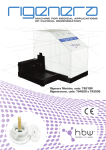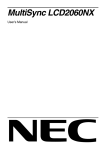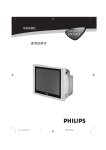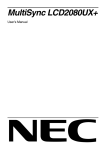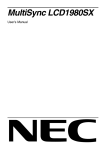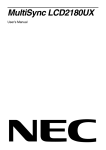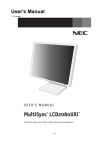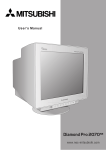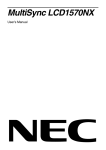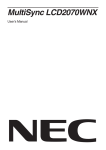Download SGI Silicon Graphics F190 User guide
Transcript
Silicon Graphics® F190 Flat Panel Display User Guide TCO’99 Congratulations! You have just purchased a TCO’99 approved and labeled product! Your choice has provided you with a product developed for professional use. Your purchase has also contributed to reducing the burden on the environment and also to the further development of environmentally adapted electronics products. Why do we have environmentally labelled computers? In many countries, environmental labelling has become an established method for encouraging the adaptation of goods and services to the environment. The main problem, as far as computers and other electronics equipment are concerned, is that environmentally harmful substances are used both in the products and during the manufacturing. Since it has not been possible for the majority of electronics equipment to be recycled in a satisfactory way, most of these potentially damaging substances sooner or later enter Nature. There are also other characteristics of a computer, such as energy consumption levels, that are important from the viewpoints of both the work (Internal) and natural (external) environments. Since all methods of conventional electricity generation have a negative effect on the environment (acidic and climate-influencing emissions, radioactive waste, etc.), it is vital to conserve energy. Electronics equipment in offices consume an enormous amount of energy since they are often left running continuously. What does labelling involve? This product meets the requirements for the TCO’99 scheme which provides for international and environmental labelling of personal computers. The labelling scheme was developed as a joint effort by the TCO (The Swedish Confederation of Professional Employees), Svenska Naturskyddsforeningen (The Swedish Society for Nature Conservation) and Statens Energimyndighet (The Swedish National Energy Administration). The requirements cover a wide range of issues: environment, ergonomics, usability, emission of electrical and magnetic fields, energy consumption and electrical and fire safety. The environmental demands concern restrictions on the presence and use of heavy metals, brominated and chlorinated flame retardants, CFCs (freons) and chlorinated solvents, among other things. The product must be prepared for recycling and the manufacturer is obliged to have an environmental plan which must be adhered to in each country where the company implements its operational policy. The energy requirements include a demand that the computer and/or display, after a certain period of inactivity, shall reduce its power consumption to a lower level in one or more stages. The length of time to reactivate the computer shall be reasonable for the user. Labelled products must meet strict environmental demands, for example, in respect of the reduction of electric and magnetic fields, physical and visual ergonomics and good usability. Environmental Requirements Flame retardants Flame retardants are present in printed circuit boards, cables, wires, casings and housings. In turn, they delay the spread of fire. Up to thirty percent of the plastic in a computer casing can consist of flame retardant substances. Most flame retardants contain bromine or chloride and these are related to another group of environmental toxins, PCBs, which are suspected to give rise to severe health effects, including reproductive damage in fisheating birds and mammals, due to the bio-accumulative* processes. Flame retardants have been found in human blood and researchers fear that disturbances in foetus development may occur. TCO’99 demand requires that plastic components weighing more than 25 grams must not contain flame retardants with organically bound chlorine and bromine. Flame retardants are allowed in the printed circuit boards since no substitutes are available. Lead** Lead can be found in picture tubes, display screens, solders and capacitors. Lead damages the nervous system and in higher doses, causes lead poisoning. TCO’99 requirement permits the inclusion of lead since no replacement has yet been developed. Cadmium** Cadmium is present in rechargeable batteries and in the colourgenerating layers of certain computer displays. Cadmium damages the nervous system and is toxic in high doses. TCO’99 requirement states that batteries, the colourgenerating layers of display screens and the electrical or electronics components must not contain any cadmium. TCO’99 - Continued Mercury** Mercury is sometimes found in batteries, relays and switches, Mercury damages the nervous system and is toxic in high doses. TCO’99 requirement states that batteries may not contain any Mercury. It also demands that no mercury is present in any of the electrical or electronics components associated with the display unit. CFCs (freons) CFCs (freons) are sometimes used for washing printed circuit boards. CFCs break down ozone and thereby damage the ozone layer in the stratosphere, causing increased reception on Earth of ultraviolet light with consequent increased risks of skin cancer (malignant melanoma). The relevant TCO’99 requirement; Neither CFCs nor HCFCs may be used during the manufacturing and assembly of the product or its packaging. *Bio-accumulative is defined as substances which accumulate within living organisms. **Lead, Cadmium and Mercury are heavy metals which are Bio-accumulative. To obtain complete information on the environmental criteria document, order from: TCO Development Unit SE-114 94 Stockholm SWEDEN FAX Number: +46 8 782 92 07 E-mail (Internet): [email protected] You may also obtain current information on TCO’99 approved and labelled products by visiting their website at: http:/ /www.tcodevelopment.com/ Manufacturer’s Recycling and Energy Information SGI is strongly committed to environmental protection and sees recycling as one of the company’s top priorities in trying to minimize the burden placed on the environment. We are engaged in developing environmentally-friendly products. For more information on SGI’s Environmental Policy and Practices, please visit our website at http://www.sgi.com/company_info/environment/policy.html Country-specific recycling programs can also be found at: Sweden - http://www.el-retur.se Germany - http://www.recyclingpartner.de/ Holland - http://www.mirec.nl/ Japan - http://www.diarcs.com/ Energy saving: This monitor features an advanced energy saving capability. When a VESA Display Power Management Signaling (DPMS) Standard signal is sent to the monitor, the Energy Saving mode is activated. The monitor enters a single Energy Saving mode. Mode Power consumption LED color Normal Operation Approx. 38W Green Energy Saving Mode Less than 2W Amber Off Mode Less than 0.1W Unlit Index Safety Instruction .................. English-1 Warning ................................... English-1 Caution .................................... English-1 Contents .................................. English-2 Quick Start .............................. English-3 Controls ................................... English-6 Recommended use ................ English-8 Specifications ..................... English-10 Features ................................ English-11 Troubleshooting ................... English-12 Sicherheitsvorkehrungen .... Deutsch-1 Warnung ................................. Deutsch-1 Vorsicht .................................. Deutsch-1 Inhalt ....................................... Deutsch-2 Schnellstart ........................... Deutsch-3 Bedienelemente .................... Deutsch-6 Einsatzempfehlungen .......... Deutsch-9 Technische Daten ............... Deutsch-11 Merkmale und Funktionen . Deutsch-12 Fehlerbehebung .................. Deutsch-13 Instrucciones de seguridad Español-1 Advertencia ........................... Español-1 Peligro .................................... Español-1 Contenido .............................. Español-2 Inicio rápido .......................... Español-3 Controles ................................ Español-6 Uso recomendado ................ Español-9 Especificaciones................. Español-11 Características .................... Español-12 Solución de problemas .......... Español-13 Consignes de sécurité ........ Français-1 Avertissement ...................... Français-1 Attention................................ Français-1 Sommaire .............................. Français-2 Démarrage rapide ................ Français-3 Commandes .......................... Français-6 Conseils d’utilisation .......... Français-9 Spécifications .................... Français-11 Caractéristiques ................. Français-12 Résolution des problémes Français-13 Istruzioni di sicurezza ........... Italiano-1 Avvertenza .............................. Italiano-1 Attenzione ............................... Italiano-1 Contenuto ............................... Italiano-2 Avvio veloce ........................... Italiano-3 Controlli ................................... Italiano-6 Uso consigliato ...................... Italiano-9 Specifiche tecniche ............. Italiano-11 Caratteristiche ...................... Italiano-12 Ricerca guasti ...................... Italiano-13 ご 使 用 の 前 に ..................... 日 本 語 -1 語-2 語安全のために必ず守ること . . 日本語 各 部 の 名 称 ........................ 日 本 語 -5 語接 続 .................................. 日 本 語 -7 語画 面 調 節 ............................ 日 本 語 -9 語特 長 ・ 機 能 ...................... 日 本 語 -11 語-13 困 っ た と き ...................... 日 本 語 語付 録 ................................ 日 本 語 -15 語 ! KKKKKKKKKKKKKKKKKKKKKKKKKKKKKKKKKKKKKKKKKKKKK KKKKKKKKKKKKKKKKKKKKKKKKKKKKKKKKKKKKKKKKKKKKKKKKKKKKKK KKKKKKKKKKKKKKKKKKKKKKKKKKKKKKKKKKKKKKKKKKKKKKKKKKKKKK KKKKKKKKKKKKKKKKKKKKKKKKKKKKKKKKKKKKKKKKKKKKKKKKKKKKK ! KKKKKKKKKKKKKKKKKKKKKKKKKKKKKKKKKKKKKKKKKKKK KKKKKKKKKKKKKKKKKKKKKKKKKKKKKKKKKKKKKKKKKKKKKKKKKKKKK ! KKKKKKKKKKKKKKKKKKKKKKKKKKKKKKKKKKKKKKKKKKKK KKKKKKKKKKKKKKKKKKKKKKKKKKKKKKKKKKKKKKKKKKKKKKKKKKK KKKKKKKKKKKKKKKKKKKKKKKKKKKKKKKKKKKKKKKKKKKKKKKKKKKK ! KKKKKKKKKKKKKKKKKKKKKKKKKKKKKKKKKKKKKKKKKK ! JN ! JN ! JN ! JO ! JP ! JS ! JU ! JNM ! JNN ! JNO ! KKKKKKKKKKKKKKKKKKKKKKKKKKKKKKKKKKKKKKKKKKKKKKK ! JN KKKKKKKKKKKKKKKKKKKKKKKKKKKKKKKKKKKKKKKKKKKKKKKKKKKKKKKK ! JN KKKKKKKKKKKKKKKKKKKKKKKKKKKKKKKKKKKKKKKKKKKKKKKKKKKKKKKK ! JN KKKKKKKKKKKKKKKKKKKKKKKKKKKKKKKKKKKKKKKKKKKKKKKKKKKKKKKK ! JO ! KKKKKKKKKKKKKKKKKKKKKKKKKKKKKKKKKKKKKKKKKKKKKKK ! JP KKKKKKKKKKKKKKKKKKKKKKKKKKKKKKKKKKKKKKKKKKKKKKKKKKKKKKKK ! JS ! KKKKKKKKKKKKKKKKKKKKKKKKKKKKKKKKKKKKKKKKKKKKKKK ! JU KKKKKKKKKKKKKKKKKKKKKKKKKKKKKKKKKKKKKKKKKKKKKKKKKKKKK ! JNM KKKKKKKKKKKKKKKKKKKKKKKKKKKKKKKKKKKKKKKKKKKKKKKKKKKKK ! JNN ! KKKKKKKKKKKKKKKKKKKKKKKKKKKKKKKKKKKKKKKKKKKK ! JNO = KKKKKKKKKKKKKKKKKKKKKKKKKKKKKKKKKK JN KKKKKKKKKKKKKKKKKKKKKKKKKKKKKKKKKKKKKKKKKKKKKK JN KKKKKKKKKKKKKKKKKKKKKKKKKKKKKKKKKKKKKKKKKKKKKK JN KKKKKKKKKKKKKKKKKKKKKKKKKKKKKKKKKKKKKKKKKKKKKK JO = KKKKKKKKKKKKKKKKKKKKKKKKKKKKKKKKKK JP = KKKKKKKKKKKKKKKKKKKKKKKKKKKKKKKKKK JS == KKKKKKKKKKKKKKKKKKKKKKKKKKKKK JV KKKKKKKKKKKKKKKKKKKKKKKKKKKKKKKKKKKKKKKKKKKKK JNN KKKKKKKKKKKKKKKKKKKKKKKKKKKKKKKKKKKKKKKKKKKKK JNO == KKKKKKKKKKKKKKKKKKKKKKKKKKK JNP WARNING TO PREVENT FIRE OR SHOCK HAZARDS, DO NOT EXPOSE THIS UNIT TO RAIN OR MOISTURE. ALSO, DO NOT USE THIS UNIT’S POLARIZED PLUG WITH AN EXTENSION CORD RECEPTACLE OR OTHER OUTLETS UNLESS THE PRONGS CAN BE FULLY INSERTED. REFRAIN FROM OPENING THE CABINET AS THERE ARE HIGH VOLTAGE COMPONENTS INSIDE. REFER SERVICING TO QUALIFIED SERVICE PERSONNEL. CAUTION RISK OF ELECTRIC SHOCK • DO NOT OPEN CAUTION: TO REDUCE THE RISK OF ELECTRIC SHOCK, DO NOT REMOVE COVER (OR BACK). NO USER SERVICEABLE PARTS INSIDE. REFER SERVICING TO QUALIFIED SERVICE PERSONNEL. This symbol warns user that uninsulated voltage within the unit may have sufficient magnitude to cause electric shock. Therefore, it is dangerous to make any kind of contact with any part inside this unit. This symbol alerts the user that important literature concerning the operation and maintenance of this unit has been included. Therefore, it should be read carefully in order to avoid any problems. Canadian Department of Communications Compliance Statement DOC: This Class B digital apparatus meets all requirements of the Canadian Interference-Causing Equipment Regulations. C-UL: Bears the C-UL Mark and is in compliance with Canadian Safety Regulations according to CSA C22.2 No.60950. FCC Information 1. Use the attached specified cables with the color display so as not to interfere with radio and television reception. (1) Please use the supplied power cable or equivalent to ensure FCC compliance. (2) Please use the supplied shielded video signal cable. Use of other cables and adapters may cause interference with radio and television reception. 2. This equipment has been tested and found to comply with the limits for a Class B digital device, pursuant to part 15 of the FCC Rules. These limits are designed to provide reasonable protection against harmful interference in a residential installation. This equipment generates, uses, and can radiate radio frequency energy, and, if not installed and used in accordance with the instructions, may cause harmful interference to radio communications. However, there is no guarantee that interference will not occur in a particular installation. If this equipment does cause harmful interference to radio or television reception, which can be determined by turning the equipment off and on, the user is encouraged to try to correct the interference by one or more of the following measures: • Reorient or relocate the receiving antenna. • Increase the separation between the equipment and receiver. • Connect the equipment into an outlet on a circuit different from that to which the receiver is connected. • Consult your dealer or an experienced radio/TV technician for help. If necessary, the user should contact the dealer or an experienced radio/television technician for additional suggestions. The user may find the following booklet, prepared by the Federal Communications Commission, helpful: “How to Identify and Resolve RadioTV Interference Problems.” This booklet is available from the U.S. Government Printing Office, Washington, D.C., 20402, Stock No. 004-000-00345-4. No user serviceable parts inside. Do not attempt to modify this equipment. If modified, your authority to operate this equipment might be voided by FCC. ENERGY STAR® is a U.S. registered trademark. All other brands and product names are trademarks or registered trademarks of their respective owners. As an ENERGY STAR Partner, Silicon Graphics, Inc. has determined that this product meets the ENERGY STAR guidelines for energy efficiency. The ENERGY STAR emblem does not represent EPA endorsement of any product or service. All other trademarks mentioned in this manual are the property of their respective owners. English-1 English Safety Instruction Contents Your new Silicon Graphics F190 Flat Panel Display box* should contain the following: • Display with tilt base • User’s Manual • Video Signal Cable (DVI-D to DVI-D) • Cable Management Cover Video Signal Cable (DVI-D to DVI-D) User's Manual * Cable Management Cover Remember to save your original box and packing material to transport or ship the display. English-2 English Quick Start To attach the F190 Display to your system, follow these instructions: 1. Turn off the power to your computer. 2. For Workstations with DVI digital output: Connect the DVI signal cable (included) to the connector of the graphics card in your system (Figure A). Tighten all screws. For Workstations with Analog output: Connect the 15-pin mini D-SUB signal cable (supplied with the Workstation) to the connector of the graphics card in your system (Figure B). Tighten all screws. 3. Connect either or the 15-pin mini D-SUB of the video signal cable and DVI signal cable to the appropriate connector on the back of the display (Figure C). 4. Connect one end of the power cord to the F190 Display and the other end to the power outlet. Collect cables and keep them at backside of the stand and cover the cables by the optional Cable management Cover (Figure C). Please check Tilt, Rise and Lower monitor screen when you manage cables. 5. The vacation switch on the left side of the display must be turned on (Figure D). Turn on the display with the front power button and the computer. Note: The vacation switch is a true on/off switch. If this switch is on the OFF position, the display cannot be turned on using the front button. DO NOT switch on/off repeatedly. 6. Analog input only: No-Touch Auto Adjust automatically adjusts the display to optimal settings upon initial setup for most timings. For further adjustments, use the following OSD controls: •Auto Adjust Contrast •Auto Adjust Refer to the Controls section of this User’s Manual for a full description of these OSD controls. Note: If you have any problems, please refer to the Troubleshooting section of this User’s Manual. 5 1 10 15 6 11 D-Sub Connector DVI Connector Figure B Figure A English-3 Quick Start - Continued INPUT1 INPUT2 Figure C Power Button Vacation Switch Figure D Raise and Lower Monitor Screen The monitor may be raised or lowered. To raise or lower screen, place hands on each side of the monitor and lift or lower to the desired height (Figure RL 1). Figure RL 1 Note: Handle with care when raising or lowering the monitor screen. English-4 Tilt and swivel Grasp both sides of the display screen with your hands and adjust the tilt and swivel as desired (Figure E). Figure E Note: Handle with care when tilting the monitor screen. Remove Display Stand for Mounting To prepare the monitor for alternate mounting purposes: 1. Disconnect all cables. 2. Place hands on each side of the monitor and lift up to the highest position. 3. Place monitor face down on a non-abrasive surface (Place the screen on a 55 mm/2.2 inch platform so that the stand is parallel with the surface) (Figure F). 55 mm Figure F 4. Remove the 4 screws connecting the display to the stand and lift off the stand assembly (Figure G). The display is now ready for mounting in an alternate manner. 5. Connect the AC cord and signal cable to the back of the display (Figure H). 6. Reverse this process to reattach stand. Note: Use only VESA-compatible alternative mounting method. (100mm pitch) Note: Handle with care when removing display stand. Figure G Figure H Caution: Please use the attached screws (4pcs) as shown in the picture when installing. To meet the safety requirements, the display must be mounted to an arm which guaranties the necessary stability under consideration of the weight of the display. The LCD display shall only be used with an approved arm (e.g. GS mark). English-5 English Quick Start - Continued Controls OSD (On-Screen Display) control buttons on the front of the display function as follows: To access OSD menu, press any of the control buttons (EXIT, To change signal input, press the SELECT button. NOTE: , , –, +). OSD must be closed in order to change signal input. Menu EXIT Exits the OSD controls. Exits to the OSD main menu. / Moves the highlighted area left/right to select control menus. Moves the highlighted area up/down to select one of the controls. -/+ Moves the bar left/right to increase or decrease the adjustment. SELECT/1 RESET NOTE: 2 Active Auto Adjust function. Enter the OSD controls. Enter the OSD sub menu. Resets the highlighted control menu to the factory setting. When RESET is pressed in the main and sub-menu, a warning window will appear allowing you to cancel the RESET function by pressing the EXIT button. Brightness/Contrast Controls BRIGHTNESS Adjusts the overall image and background screen brightness. CONTRAST Adjusts the image brightness in relation to the background. AUTO CONTRAST (Analog input only) Adjusts the image displayed for non-standard video inputs. Auto Adjust (Analog input only) Automatically adjusts the Image Position and H. Size settings and Fine settings. Position Controls LEFT / RIGHT (Analog input only) Controls Horizontal Image Position within the display area of the LCD. DOWN / UP (Analog input only) Controls Vertical Image Position within the display area of the LCD. H.SIZE (Analog input only) Adjusts the horizontal size by increasing or decreasing this setting. Should the “AUTO Adjust function” do not give you a satisfactory picture setting, a further tuning can be performed using the “H.Size” function (dot clock). For this a Moiré test pattern could be used. This function may alter the width of the picture. Use left/Right Menu to center the image on the screen. If the H.Size is wrongly calibrated, the result would look like on the left drawing. The image should be homogeneous. When H.SIZE value is wrong. When H.SIZE value is improved. When H.SIZE value is correct. FINE (Analog input only) Improves focus, clarity and image stability by increasing or decreasing this setting. If the “Auto Adjust function” and the “H.Size” function do not give you a satisfactory picture setting, a fine tuning can be performed manually using the “Fine” function. It improves focus, clearity and image stability by increasing or decreasing this setting. For this a Moiré test pattern could be used. If the Fine value is wrongly calibrated, the result would look like on the left drawing. The image should be homogeneous. When FINE value is wrong. English-6 When FINE value is correct. English Controls - Continued Color Control Systems Color Control Systems: Six color presets select the desired color setting (sRGB and NATIVE color presets are standard and cannot be changed). R, G, B: Increases or decreases Red, Green or Blue color depending upon which is selected. The change in color will appear on screen and the direction (increase or decrease) will be shown by the bars. sRGB: sRGB mode dramatically improves the color fidelity in the desktop environment by a single standard RGB color space. With this color supported environment, the operator could easily and confidently communicate colors without further color management overhead in the most common situations. NATIVE: Original color presented by the LCD panel that is unadjustable. Tools LANGUAGE: OSD control menus are available in seven languages. OSD POSITION: You can choose where you would like the OSD control image to appear on your screen. Selecting OSD Location allows you to manually adjust the position of the OSD control menu left, right, down or up. OSD TURN OFF: The OSD control menu will stay on as long as it is use. In the OSD Turn Off submenu, you can select how long the display waits after the last touch of a button to shut off the OSD control menu. OSD LOCK OUT: This control completely locks out access to all OSD control functions. When attempting to activate OSD controls while in the Lock Out mode, a screen will appear indicating the OSD controls are locked out. There are two types of OSD LOCK OUT: OSD LOCK OUT with BRIGHTNESS and CONTRAST control: To activate the OSD Lock Out function, press SELECT, then “+” key and hold down simultaneously. To deactivate the OSD Lock Out, press SELECT, then “+” key and hold down simultaneously. BRIGHTNESS and CONTRAST can be adjusted while in the lock out mode. OSD LOCK OUT with no control: To activate the OSD Lock Out function, press SELECT, then “>” key and hold down simultaneously. To deactivate the OSD Lock Out, press SELECT, then “>” key and hold down simultaneously. No controls can be adjusted while in the lock out mode. RESOLUTION NOTIFIER: This optimal resolution is 1280 x 1024. If ON is selected, a message will appear on the screen after 30 seconds, notifying you that the resolution is not at 1280 x 1024. HOT KEY: You can adjust the brightness and contrast directly. When this function is set to ON, you can adjust the brightness with or , contrast with + or - key, while the OSD menu is off. OFF TIMER: Monitor will automatically power-down when the end user has selected a pre-determined amount of time. FACTORY PRESET: Selecting Factory Preset allows you to reset all OSD control settings back to the factory settings. The RESET button will need to be held down for several seconds to take effect. Individual settings can be reset by highlighting the control to be reset and pressing the RESET button. Information DISPLAY MODE: Provides information about the current resolution display and technical data including the preset timing being used and the horizontal and vertical frequencies. Increases or decreases the current resolution. MONITOR INFO.: Indicates the model and serial numbers of your display. OSD Warning OSD Warning menus disappear with Exit button. NO SIGNAL: This function gives a warning when there is no Horizontal or Vertical Sync. After power is turned on or when there is a change of input signal, the No Signal window will appear. RESOLUTION NOTIFIER: This function gives a warning of use with optimized resolution. After power is turned on or when there is a change of input signal or the video signal doesn’t have proper resolution, the Resolution Notifier window will open. This function can be disabled in the TOOL menu. OUT OF RANGE: This function gives a recommendation of the optimized resolution and refresh rate. After the power is turned on or there is a change of input signal or the video signal doesn’t have proper timing, the Out Of Range menu will appear. English-7 Recommended use Safety Precautions and Maintenance FOR OPTIMUM PERFORMANCE, PLEASE NOTE THE FOLLOWING WHEN SETTING UP AND USING THE LCD COLOR DISPLAY: • DO NOT OPEN THE DISPLAY. There are no user serviceable parts inside and opening or removing covers may expose you to dangerous shock hazards or other risks. Refer all servicing to qualified service personnel. • Do not spill any liquids into the cabinet or use your display near water. • Do not insert objects of any kind into the cabinet slots, as they may touch dangerous voltage points, which can be harmful or fatal or may cause electric shock, fire or equipment failure. • Do not place any heavy objects on the power cord. Damage to the cord may cause shock or fire. • Do not place this product on a sloping or unstable cart, stand or table, as the display may fall, causing serious damage to the display. • Do not place any objects onto the display and do not use the display outdoors. • The inside of the fluorescent tube located within the LCD display contains mercury. Please follow the bylaws or rules of your municipality to dispose of the tube properly. Immediately unplug your display from the wall outlet and refer servicing to qualified service personnel under the following conditions: • When the power supply cord or plug is damaged. • If liquid has been spilled, or objects have fallen into the display. • If the display has been exposed to rain or water. • If the display has been dropped or the cabinet damaged. • If the display does not operate normally by following operating instructions. • Do not bend power cord. • Do not use display in high temperature, humid, dusty, or oily areas. • Do not cover vent on display. • If display is broken, do not come in contact with the liquid crystal. • If glass is broken. Handle with care. CAUTION • • Allow adequate ventilation around the display so that heat can properly dissipate. Do not block ventilated openings or place the display near a radiator or other heat sources. Do not put anything on top of display. • The power cable connector is the primary means of detaching the system from the power supply. The display should be installed close to a power outlet which is easily accessible. • Handle with care when transporting. Save packaging for transporting. Image Persistence: Image persistence is when a residual or “ghost” image of a previous image remains visible on the screen. Unlike CRT monitors, LCD monitor’s image persistence is not permanent, but constant images being displayed for a long period of time should be avoided. To alleviate image persistence, turn off the monitor for as long as the previous image was displayed. For example, if an image was on the monitor for one hour and a residual image remains, the monitor should be turned off for one hour to erase the image. NOTE: As with all personal display devices, Silicon Graphics recommends using a moving screen saver at regular intervals whenever the screen is idle or turning off the monitor when not in use. English-8 CORRECT PLACEMENT AND ADJUSTMENT OF THE DISPLAY CAN REDUCE EYE, SHOULDER AND NECK FATIGUE. CHECK THE FOLLOWING WHEN YOU POSITION THE DISPLAY: • For optimum performance, allow 20 minutes for warm-up. • Adjust the display height so that the top of the screen is at or slightly below eye level. Your eyes should look slightly downward when viewing the middle of the screen. • Position your display no closer than 40 cm and no further away than 70 cm from your eyes. The optimal distance is 50 cm. • Rest your eyes periodically by focusing on an object at least 6 m away. Blink often. • Position the display at a 90° angle to windows and other light sources to minimize glare and reflections. Adjust the display tilt so that ceiling lights do not reflect on your screen. • If reflected light makes it hard for you to see your screen, use an antiglare filter. • Clean the LCD display surface with a lint-free, non-abrasive cloth. Avoid using any cleaning solution or glass cleaner! • Adjust the display’s brightness and contrast controls to enhance readability. • Use a document holder placed close to the screen. • Position whatever you are looking at most of the time (the screen or reference material) directly in front of you to minimize turning your head while you are typing. • Avoid displaying fixed patterns on the display for long periods of time to avoid image persistence (after-image effects). • Get regular eye checkups. Ergonomics To realize the maximum ergonomics benefits, we recommend the following: • Use the preset Size and Position controls with standard signals. • Use the preset Color Setting. • Use non-interlaced signals with a vertical refresh rate between 60-75 Hz. • Do not use primary color blue on a dark background, as it is difficult to see and may produce eye fatigue to insufficient contrast. English-9 English Recommended use - Continued Specifications Monitor Specifications F190 Flat Panel Display LCD Module Diagonal : 48cm/19 inches Viewable Image Size : 48cm/19 inches Native Resolution (Pixel Count): 1280 x 1024 Input Signal Video : Sync : Display Colors Analog input : Synchronization Range Horizontal: Vertical: Image Formation Time Resolutions Supported Active Display Area Horiz.: Vert.: Power Supply Current Rating Dimensions Without stand: Weight Without tilt stand: Environmental Considerations Operating Temperature : Humidity : Feet : Storage Temperature : Humidity : Feet : Regulations Safety: Notes Active matrix; thin film transistor (TFT) liquid crystal display (LCD); 0.294 mm dot pitch; 225cd/m2 white luminance; 500:1 contrast ratio, typical. Digital Input: DVI ANALOG 0.7 Vp-p/75 Ohms Separate sync. TTL Level 16,777,216 Depends on display card used. 31.5 kHz to 81.1 kHz (Analog) Automatically 31.5 kHz to 80.0 kHz (Digital) 56 Hz to 75 Hz Automatically 25 ms (Typ.) 720 x 400*1 :VGA text Some systems may not support 640 x 480*1 at 60 Hz to 75 Hz all modes listed. 800 x 600*1 at 56 Hz to 75 Hz 832 x 624*1 at 5 Hz 1024 x 768*1 at 60 Hz to 75 Hz 1152 x 870*1 at 75 Hz 1280 x 1024 at 60 Hz ......................... Recommended resolution 376.3 mm/14.8 inches 301.1 mm/11.9 inches AC100-120 V/220-240 V @ 50/60Hz 0.75 A@100-120 V, 0.4A @ 220-240 V 416.3 mm (W) x 388.7-498.7 mm (H) x 190 mm (D) 16.4 inches (W) x 15.3-19.6 inches (H) x 7.5 inches (D) 416.3 mm (W) x 352.8 mm (H) x 76 mm (D) 16.4 inches (W) x 13.9 inches (H) x 3.0 inches (D) 8.0 kg (17.6 lbs) 5.8 kg (12.8 lbs) 5°C to 35°C/41°F to 95°F 30% to 80% 0 to 3,000 m/0 to 10,000 Feet -10°C to 60°C/14°F to 140°F 10% to 85% 0 to 12,000 m/0 to 40,000 Feet UL60950 (UL), CSA C22.2 No.60950 (c-UL), EN60950 (TÜV-GS), CE-Marking CCC EMC: FCC Class-B, DOC Class-B, EN55022 Class-B, VCCI Class-B, EN61000-3-2, EN61000-3-3, EN55024 CCC, MIC, BSMI, C-Tick, CE-Marking Other: MPR-II ISO13406-2 TCO’99 International ENERGY STAR Program *1 Interpolated Resolutions: When resolutions are shown that are lower than the pixel count of the LCD module, text may appear different. This is normal and necessary for all current flat panel technologies when displaying non-native resolutions full screen. In flat panel technologies, each dot on the screen is actually one pixel, so to expand resolutions to full screen, an interpolation of the resolution must be done. NOTE: Technical specifications are subject to change without notice. English-10 Reduced Footprint: Provides the ideal solution for environments requiring superior image quality but with size and weight limitations. The display’s small footprint and low weight allow it to be moved or transported easily from one location to another. OSD (On-Screen Display) Controls: Allow you to quickly and easily adjust all elements of your screen image via simple to use on-screen menus. No-Touch Auto Adjust (Analog input only): No-Touch Auto Adjust automatically adjust the monitor to optimal settings upon initial setup. ErgoDesign Features: Enhance human ergonomics to improve the working environment, protect the health of the user and save money. Examples include OSD controls for quick and easy image adjustments, tilt base for preferred angle of vision, small footprint and compliance with MPRII and TCO guidelines for lower emissions. Plug and Play: The Microsoft® solution with the Windows®95/98/Me/2000/XP operating system facilitates setup and installation by allowing the display to send its capabilities (such as screen size and resolutions supported) directly to your computer, automatically optimizing display performance. IPM (Intelligent Power Manager) System: Provides innovative power-saving methods that allow the display to shift to a lower power consumption level when on but not in use, saving two-thirds of your display energy costs, reducing emissions and lowering the air conditioning costs of the workplace. Multiple Frequency Technology: Automatically adjusts display to the display card’s scanning frequency, thus displaying the resolution required. FullScan Capability: Allows you to use the entire screen area in most resolutions, significantly expanding image size. VESA Standard Mounting Interface: Allows users to connect the SGI display to any VESA standard third party mounting arm or bracket. Allows for the display to be mounted on a wall or an arm using any third party compliant device. English-11 English Features Troubleshooting No picture • The signal cable should be completely connected to the display card/computer. • The display card should be completely seated in its slot. • Check the Vacation Switch should be in the ON position. • Front Power Switch and computer power switch should be in the ON position. • Check to make sure that a supported mode has been selected on the display card or system being used. (Please consult display card or system manual to change graphics mode.) • Check the monitor and your display card with respect to compatibility and recommended settings. • Check the signal cable connector for bent or pushed-in pins. • Check the signal input, “INPUT 1” or “INPUT 2”. Power Button does not respond • Unplug the power cord of the display from the AC outlet to turn off and reset the display. • Check the Vacation Switch on the left side of the display. Image persistence • Image persistence is when a “ghost” image of an image remains on the screen even after the display has been turned off. Unlike CRT monitors, LCD display’s image persistence is not permanent. To alleviate image persistence, turn the monitor off for as long as an image was displayed. If an image was on the display for one hour and a “ghost” of that image remains, the display should be turned off for one hour to erase the image. NOTE: As with all personal display devices, it is recommended to use a moving screen saver at regular intervals whenever the screen is idle or turning off the monitor when not in use. Message “OUT OF RANGE” is displayed (screen is either blank or shows rough images only) • Image is displayed only roughly (pixels are missing) and OSD warning “OUT OF RANGE” is displayed: Either signal clock or resolution is too high. Choose one of the supported modes. • OSD warning “OUT OF RANGE” is displayed on a blank screen: Signal frequency is out of range. Choose one of the supported modes. Image is unstable, unfocused or swimming is apparent • Signal cable should be completely attached to the computer. • Use the OSD Image Adjust controls to focus and adjust display by increasing or decreasing the fine total. When the display mode is changed, the OSD Image Adjust settings may need to be re-adjusted. • Check the display and your display card with respect to compatibility and recommended signal timings. • If your text is garbled, change the video mode to non-interlace and use 60Hz refresh rate. LED on display is not lit (no green or amber color can be seen) • Power Switch should be in the ON position and power cord should be connected. Display image is not sized properly • Use the OSD Image Adjust controls to increase or decrease the Coarse total. • Check to make sure that a supported mode has been selected on the display card or system being used. (Please consult display card or system manual to change graphics mode.) No Video • If no video is present on the screen, turn the Power button off and on again. • Make certain the computer is not in a power-saving mode (touch the keyboard or mouse). English-12


















